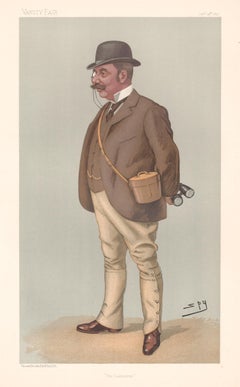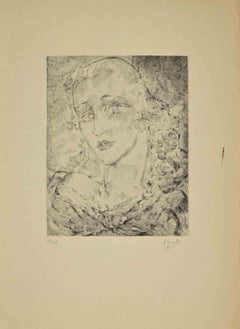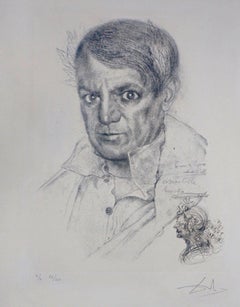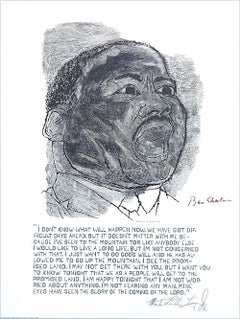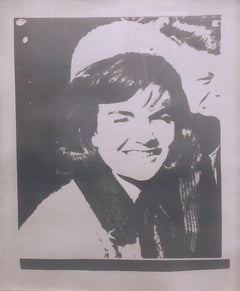Portrait Figurative Prints
to
376
1,073
398
294
191
78
Overall Width
to
Overall Height
to
731
436
103
87
63
41
38
31
29
15
10
6
3
2
78
63
34
26
20
96
584
894
466
26
37
54
56
40
35
89
168
100
64
86
1,635
287
108
26,948
14,776
10,577
9,084
7,785
7,001
4,598
4,164
2,411
2,041
1,925
1,866
1,659
1,471
1,460
1,447
1,431
1,295
1,223
1,104
652
650
310
171
155
160
1,098
839
763
Art Subject: Portrait
Female Portrait (Head of Black Woman) Black Artist
Located in Wilton Manors, FL
Ellen Tiberino (1937-1992).
Head of Woman, ca. 1980. edition 450.
Offset print on paper, image measuring 15.5 x 21 inches. 21.5 x 27 inches in matting.
Hand signed and numbered i...
Category
1970s Abstract Figurative Prints
Materials
Offset
'Badminton', Alfred Watson, Vanity Fair caricature portrait, 1897
Located in Melbourne, Victoria
'Badminton'
Chromolithograph. 1897.
Vanity Fair portrait of Alfred Edward Thomas Watson (1849-1922) who was a Music and Drama Critic. He wrote for the Saturday Review and occasion...
Category
Late 19th Century Victorian Figurative Prints
Materials
Lithograph
Ninetta - Etching by Arthure Greuell - Mid-20th century
Located in Roma, IT
Ninetta is an artwork realized by Arthur Greuell (1891-1966) in 1950.
Etching on paper. Hand-signed on the lower right margin. Limited edition n. 25/65 ex.
Good condition on a yell...
Category
Mid-20th Century Modern Figurative Prints
Materials
Etching
Portrait of Picasso
Located in Hollywood, FL
ARTIST: Salvador Dali
TITLE: Portrait of Picasso
MEDIUM: Etching
SIGNED: Hand Signed
EDITION NUMBER: a/b 66/200
MEASUREMENTS: 19" x 31"
YEAR: 1970
FRAMED: No
CONDITION: Exc...
Category
1970s Surrealist Figurative Prints
Materials
Etching
MARTIN LUTHER KING JR. I Have A Dream, Black Portrait Head Civil Rights Activist
By Ben Shahn
Located in Union City, NJ
BEN SHAHN - Martin Luther King, Jr. - I Have A Dream is a limited run, plate signed, commemorative lithograph recreated after the wood engraving by Stefan Martin(1936 - 1994), an American wood engraver and illustrator. Printed using traditional lithography methods in 1981 on fine quality, archival Somerset printmaking paper, 100% acid free. Features a striking black and white portrait head portraying the fine wood engraved image of civil rights leader - Dr. Martin Luther King, Jr. along with text from his famed inspirational, I’ve been to the mountaintop’ speech. Printed signatures of Ben Shahn in dark reddish brown ink and Martin Luther King Jr. in gray ink. (see Photos) Artists copyright text printed...
Category
1980s Contemporary Portrait Prints
Materials
Lithograph
JACQUELINE KENNEDY I FS II.13
By Andy Warhol
Located in Aventura, FL
Jacqueline Kennedy I, from 11 Pop Artists I. Screenprint in silver, on wove paper. Artist's stamped signature on the reverse and numbered. From the edition of 200. Published by O...
Category
1960s Pop Art Figurative Prints
Materials
Screen
Couple - Etching by Edouard Chimot - 1930s
Located in Roma, IT
Couple is an etching realized by Edouard Chimot in the 1930s.
Signed on the plate by the artist on the lower right corner.
Good conditions.
Édouard Chimot (26 November 1880 – 7 Ju...
Category
1930s Modern Figurative Prints
Materials
Etching
$479 Sale Price
30% Off
Yoshitomo Nara - The Little Star Dweller
Located in London, GB
Yoshitomo Nara
The Little Star Dweller
Offset lithograph on paper
Sheet size: 51.5 x 36.4 cm
Stamped with title, artist's name, copyright and year
published by N's Yard, Japan
Category
2010s Contemporary Portrait Prints
Materials
Offset
VOTE BIDEN, signed Lt Ed screenprint based upon Warhol's portrait of McGovern
Located in New York, NY
Dread Scott
VOTE BIDEN, 2020
Screenprint on wove paper
Signed, dated and numbered 24/100 in graphite pencil on the back
26 × 26 inches
Unframed
The screenprint, which references And...
Category
2010s Contemporary Portrait Prints
Materials
Screen
Don-Key – English School, 19th century
Located in Middletown, NY
A rare, extensively hand-colored impression of this charming British satirical image.
London: 1830.
Lithograph with hand coloring in watercolor on cream wove paper, 12 1/4 x 9 5/1...
Category
Early 19th Century English School Figurative Prints
Materials
Watercolor, Handmade Paper, Lithograph
Icart, Sans titre, Le Sopha (after)
By Louis Icart
Located in Southampton, NY
La pointe sèche etching on vélin de Rives filigrané à notre nom paper. Paper size: 9.5 x 7.5 inches; image size: 6.5 x 4.5 inches. Inscription: unsigned and unnumbered, as issued. No...
Category
1930s Modern Figurative Prints
Materials
Drypoint, Etching
$876 Sale Price
20% Off
Old Man Reading
Located in London, GB
Accompanied by a lantern, an elderly man sits alone, engrossed in a newspaper. Benton used a lithographic process to draw and produce this image. He renders the face and paper well-l...
Category
1940s American Modern Figurative Prints
Materials
Lithograph
Benjamin Franklin, 19th century American political portrait engraving print
Located in Melbourne, Victoria
Benjamin Franklin
Steel-engraving by WJ Edwards after Joseph Siffred Duplessis. C1860. . Vignette below image titled 'Declaration of Independence'.
When Franklin arrived in France ...
Category
Mid-19th Century Naturalistic Portrait Prints
Materials
Engraving
Icart, Composition, Le Sopha (after)
By Louis Icart
Located in Southampton, NY
La pointe sèche etching on vélin de Rives filigrané à notre nom paper. Paper size: 9.5 x 7.5 inches; image size: 6.5 x 4.5 inches. Inscription: unsigned and unnumbered, as issued. No...
Category
1930s Modern Figurative Prints
Materials
Drypoint, Etching
$876 Sale Price
20% Off
NO PLACE LIKE HOME Signed Lithograph, Black Family, Vintage Kitchen Scene
By Louis Delsarte
Located in Union City, NJ
NO PLACE LIKE HOME is a hand drawn, limited edition lithograph(not a photo reproduction or digital print) by the African American artist Louis Delsarte ...
Category
1990s Contemporary Figurative Prints
Materials
Lithograph
$2,400 Sale Price
20% Off
Icart, Sans titre, Le Sopha (after)
By Louis Icart
Located in Southampton, NY
La pointe sèche etching on vélin de Rives filigrané à notre nom paper. Paper size: 9.5 x 7.5 inches; image size: 6.5 x 4.5 inches. Inscription: unsigned and unnumbered, as issued. No...
Category
1930s Modern Figurative Prints
Materials
Drypoint, Etching
$876 Sale Price
20% Off
Debbie Harry (Blondie), Max's Kansas City 1976 Signed Edition of 10 Diamond Dust
By Bob Gruen
Located in New York, NY
Bob Gruen
Debbie Harry (Blondie) Max's Kansas City, 1976, 2018
Limited Edition silkscreen and diamond dust on 320 gram coventry rag paper
Signed, numbered 7/10 and dated in graphite ...
Category
2010s Pop Art Portrait Prints
Materials
Rag Paper, Screen, Mixed Media
'Tenant Farmers' — Depression Era, WPA
By Lou Barlow
Located in Myrtle Beach, SC
Lou Barlow (Louis Breslow), 'Tenant Farmers', color wood engraving, 1936, edition 25. Signed, titled, and numbered '15/25' in pencil. A superb, richly-inked impression, with fresh c...
Category
1930s American Modern Figurative Prints
Materials
Woodcut
John Lennon (orange version)
Located in Palm Springs, CA
Title: John Lennon
Artist: John Van Hamersveld
Medium: Color SERIGRAPH
Substrate: COVENTRY RAG 320 GSM
Paper Size: 34.25″ x 44”
Image Size: 30” x 40”
Signed and Numbered Edition Printers Proof
Year: 2007
John Van Hamersveld (born September 1, 1941) is an American graphic artist and illustrator who designed record jackets for pop and psychedelic bands from the 1960s onward. Among the 300 albums[3] are the covers of Magical Mystery...
Category
Early 2000s Contemporary Portrait Prints
Materials
Screen
Pierre-Auguste Renoir, Young Woman in Bust, 1951 (after)
Located in Southampton, NY
This exquisite lithograph after Pierre-Auguste Renoir (1841–1919), titled Jeune femme en buste (Young Woman in Bust), from the album Les Lithographies de Renoir (The Lithographs of R...
Category
1950s Impressionist Figurative Prints
Materials
Lithograph
$716 Sale Price
20% Off
La Perruque d'argent (Juffermans 6), Van Dongen, Kees van Dongen
Located in Southampton, NY
Lithograph on vélin paper. Unsigned and unnumbered, as issued. Good condition. Notes: From the album, Van Dongen, 1925. Published by Henri Floury, Paris; printed by Pierre Dumont, Pa...
Category
1920s Modern Figurative Prints
Materials
Lithograph
$3,596 Sale Price
20% Off
Felice Casorati "The Embrace" Signed Lithograph
Located in New York, NY
Felice Casorati (Italian, 1883-1963)
The Embrace, 1946
Lithograph
Sight: 15 1/2 x 11 1/4 in.
Framed: 23 1/3 x 18 2/3 x 1 in.
Signed lower left, numbered lower right
Felice Casorati (December 4, 1883 – March 1, 1963) was an Italian painter, sculptor, and printmaker. The paintings for which he is most noted include figure compositions, portraits and still lifes, which are often distinguished by unusual perspective effects.
Casorati was born in Novara. He showed an early passion for music, but abandoned his study of piano after a serious illness, and became interested in art. To please his mother he studied law at the University of Padua until 1906, but his ambition to be a painter was confirmed in 1907 when a painting of his was shown in the Venice Biennale*. The works he produced in the early years of his career were naturalistic in style, but after 1910 the influence of the symbolists* and particularly of Gustav Klimt turned him toward a more visionary approach.
In 1915 he had a solo exhibition at the Rome Secession III, where he showed several paintings and the first of his sculptures in varnished terracotta*. His military service in World War I began that year and lasted until his discharge from the army after the death of his father in 1917.
In 1918, "intrigued by the decadent atmosphere of Turin with its sinister views", he settled there with his mother and two sisters. His works of the next decade typify, in their emphasis on geometry and formal clarity, the "return to order" then prevalent in the arts as a reaction to the war. Although many critics found his work cold, cerebral, and academic, Casorati achieved international recognition as a leading figure in this movement.
Casorati himself wrote, in 1931: "In taking up, against me, the old polemic of classicism and romanticism, people rail against intellectualized and scholastic order, accuse my art of being insincere, and wilfully academic—in a word, of being neoclassical. ... since my art is born, so to speak, from within, and never has its source in changing "impressions", it is quite natural that ... static forms, and not the fluid images of passion, should be reflected in my works".
Briefly arrested in 1923 for his involvement with an anti-Fascist group, Casorati subsequently avoided antagonizing the regime. Beginning in 1923, he opened his studio to the young art students of Turin, and to emerging Italian artists such as Quinto Martini and painters of the Gruppo dei Sei (Group of Six). In 1925, one of his students was Daphne Mabel Maugham, later his wife.
One of his later students was the Italian painter Enrico Accatino...
Category
1940s Modern Portrait Prints
Materials
Lithograph
Icart, Composition, Le Sopha (after)
By Louis Icart
Located in Southampton, NY
La pointe sèche etching on vélin de Rives filigrané à notre nom paper. Paper size: 9.5 x 7.5 inches; image size: 6.5 x 4.5 inches. Inscription: unsigned and unnumbered, as issued. No...
Category
1930s Modern Figurative Prints
Materials
Drypoint, Etching
$876 Sale Price
20% Off
General Sir Francis Grenfell KCB, Vanity Fair military caricature portrait, 1889
Located in Melbourne, Victoria
Vanity Fair portrait of General Sir Francis Grenfell KCB
Chromolithograph, 1889.
Field Marshal Francis Wallace Grenfell, 1st Baron Grenfell, GCB, GCMG, PC was a British Army offic...
Category
Late 19th Century Victorian Figurative Prints
Materials
Lithograph
Raoul Dufy, The Flautist, from Letter to My Painter Raoul Dufy, 1965 (after)
By Raoul Dufy
Located in Southampton, NY
This exquisite lithograph after Raoul Dufy (1877–1953), titled Le Flutiste (The Flautist), from the folio Lettre a mon peintre Raoul Dufy (Letter to My Painter Raoul Dufy), originate...
Category
1960s Fauvist Figurative Prints
Materials
Lithograph
$716 Sale Price
20% Off
Head of a Gaul, British Museum Roman Classical sculpture photogravure
Located in Melbourne, Victoria
'Head of a Gaul'
Photogravure from a collection of photogravures depicting Greek and Roman marbles and bronzes in the British museum. Plate number above top right corner of the imag...
Category
1910s Other Art Style Portrait Prints
Materials
Photogravure
Yoshitomo Nara - Dead Of Night
Located in London, GB
Yoshitomo Nara
Dead Of Night
Offset lithograph on paper
Sheet size: 51.5 x 36.4 cm
Stamped with title, artist's name, copyright and year
published by N's Yard, Japan
Category
2010s Contemporary Portrait Prints
Materials
Offset
$477 Sale Price
45% Off
The Hon. Stephen Coleridge, Vanity Fair caricature chromolithograph print, 1910
Located in Melbourne, Victoria
'Anti-Vivisection'
Vanity Fair portrait of The Hon. Stephen Coleridge
Hentschel-Colourtype. 1910.
Stephen William Buchanan Coleridge (1854-1936) was an English author, barrister,...
Category
Early 20th Century Victorian Figurative Prints
Materials
Lithograph
Les Masques Scandalisés - Etching by J. Ensor - 1895
By James Ensor
Located in Roma, IT
Hand signed, also signed on plate.
Passepartout included : 49 x 34 cm
Image Dimensions : 8 x 12 cm
Catalogue Deteil n. 99.
This artwork is shipped from Italy. Under existing legisl...
Category
1890s Post-Impressionist Figurative Prints
Materials
Etching
$6,797 Sale Price
20% Off
Portrait of the Artist by Francis Bacon, Richard Hamilton modernist photograph
Located in New York, NY
This haunting portrait of Richard Hamilton is layered with textured lavender surrounding his form. According to the Metropolitan Museum of Art: “In 1969, at the end of a characteris...
Category
1970s Modern Portrait Prints
Materials
Screen
George Stubbs Esq, 19th century artist painter portrait engraving print
Located in Melbourne, Victoria
'George Stubbs Esq RA'
Stipple engraving by W Nicholls after Ozias Humphrey RA (1742-1810). 1809.
George Stubbs was a famous English painter of the horse and some wild animals. Th...
Category
Early 19th Century Naturalistic Portrait Prints
Materials
Engraving
HYMN SINGER / THE MINSTREL / BURL IVES -- Large Benton
Located in Santa Monica, CA
THOMAS HART BENTON (1890- 1975)
HYMN SINGER / THE MINSTREL (Portrait of Burl Ives) 1950 (Fath 74)
Lithograph signed with full signature “Thomas H. Benton” A large image, 15 ¾ x 12 i...
Category
1950s American Realist Figurative Prints
Materials
Lithograph
Elmo the Mighty, the great Elmo Lincoln original lobby cartd
Located in Spokane, WA
ELMO THE MIGHTY, original 1919 lobby card, not signed. Protected in a 16" x 20" acid-free presentation mat suitable for framing. This lobby card is over 100 years old.
Original,...
Category
1910s American Realist Figurative Prints
Materials
Offset
$300 Sale Price
20% Off
Andre Derain, Head of a Young Girl, from Verve, Revue Artistique, 1939
By André Derain
Located in Southampton, NY
This exquisite lithograph by Andre Derain (1880–1954), titled Tete de Jeune Fille (Head of a Young Girl), from Verve, Revue Artistique et Litteraire, Vol. II, No. 5–6, originates fro...
Category
1930s Fauvist Figurative Prints
Materials
Lithograph
$716 Sale Price
20% Off
La Monaca - Lithograph by Umberto Brunelleschi - 1930s
Located in Roma, IT
La Monaca is a color lithograph on ivory paper, created by the Italian artist Umberto Brunelleschi (Montemurlo 1879- Paris 1949).
Illustration for “Tales and Short Stories” by La Fo...
Category
1930s Art Nouveau Figurative Prints
Materials
Lithograph
Costume Life Drawing 1972 Signed Limited Edition
By Peter Blake
Located in Rochester Hills, MI
Artist: Sir Peter Thomas Blake
Title: Costume Life Drawing
Year: 1972
Print - Lithograph Heavy Paper
Size: 30'' x 22 5/8''
Edition: Signed and Numbered 116/125
Kelpra stamp on v...
Category
1970s Pop Art Figurative Prints
Materials
Lithograph
The Model
Located in Santa Monica, CA
RAPHAEL SOYER (1899 - 1987)
THE MODEL 1944 (Cole 64)
Lithograph Signed in pencil, edition 250, 11 ¾ x 7 ¾ Full margins, sheet 15 ¾ x 12
with deckle edge. Very slight toning to the ...
Category
1940s American Realist Figurative Prints
Materials
Lithograph
L'Enfant au Biscuit (Jean Renoir) - Lithograph by Pierre Auguste Renoir - 1899
Located in Roma, IT
Edition of 100 prints, not signed.
One of the most celebrated graphic works of Renoir, showing his son, the future Director Jean Renoir.
Belogs to the suite “L’Album d’estampes orig...
Category
1890s Impressionist Figurative Prints
Materials
Lithograph
OPHELIA (the artist's mistress / second wife) - In Celebration of Pride Month
Located in New Orleans, LA
Stone and Press Gallery is excited to offer several works in celebration of the LGBTQ community.
This elegant etching titled the gilded youth is of the second wife of the artist ...
Category
1940s American Modern Portrait Prints
Materials
Etching
YE PIPE AND BOWL Signed Lithograph Colonial Sign Painter, American Illustration
Located in Union City, NJ
Artist: Norman Rockwell, American (1894 - 1978)
Title: Ye Pipe and Bowl
Year: 1976
Medium: Hand Drawn Lithograph on Arches paper, 100% acid free, hand signed in pencil by Norman Rock...
Category
1970s Realist Portrait Prints
Materials
Lithograph
Sansho (2019), Unique Archival Pigment Print, Very Rare Edition of only 2
Located in Palm Desert, CA
FinDAC "Sansho", created in November 2019
Unique artwork: archival pigment print on 330gsm Somerset Satin Paper, size 62 x 86 cm.
Hand-embellished.
Very rare and unique from an edit...
Category
2010s Street Art Figurative Prints
Materials
Pigment
$4,875 Sale Price
35% Off
Le Bouquet Tout Fait - 20th Century, Surrealist, Lithograph, Figurative Print
Located in Sint-Truiden, BE
Color lithograph after the 1954 oil on canvas by René Magritte, printed signature of Magritte and numbered from the edition of 300.
The lithograph features the dry stamps of the Magritte Foundation & ADAGP and is countersigned in pencil by Mr. Charly Herscovici, President of the Magritte Foundation, Chairman of the Magritte Museum and unique representative of the Magritte Succession. A proof of edition is printed on the back of the lithograph, guaranteeing its authenticity.
Magritte was a Belgian surrealist artist whose witty and thought-provoking images challenged observers? preconditioned perceptions of reality. Magritte's work frequently displays a juxtaposition of ordinary objects in an unusual context, giving new meanings to familiar things.Magritte grew up in a simple and somewhat tragic household. His father was a modest tailor. His mother, who was mentally unsound, committed suicide in the year 1912. Magritte started drawing at a young age, and his first paintings, produced c. 1915, were Impressionistic in style.Magritte first worked as a draughtsman in a wallpaper factory and, in the year 1922, fell in love with and married Georgette Berger. In 1926, Magritte signed...
Category
20th Century Surrealist Figurative Prints
Materials
Lithograph
Sir Alexander Mackenzie, composer, Vanity Fair caricature portrait, 1904
Located in Melbourne, Victoria
'R.A.M'
Chromolithograph. 1904.
Vanity Fair musician portrait of Sir Alexander Campbell Mackenzie (1847 - 1935) who was a Scottish composer, conductor and teacher best known for h...
Category
Early 20th Century Victorian Figurative Prints
Materials
Lithograph
Edward Strauss, Vanity Fair composer violinist music portrait, 1895
Located in Melbourne, Victoria
'Eduard Strauss'
Chromolithograph, 1895.
Vanity Fair musician portrait of Eduard Strauss (1835 – 1916) the Austrian composer.
400mm by 270mm (sheet)
Category
Late 19th Century Victorian Figurative Prints
Materials
Lithograph
The young Bostonian 1858 portrait of a notable gentleman Boston Massachusetts
Located in Norwich, GB
A wonderful portrait of a Bostonian dated 1858, by Leopold Grozelier, the artist best known for creating the first electoral poster ever, bearing the portrait of Abraham Lincoln (186...
Category
1850s American Realist Portrait Prints
Materials
Paper, Laid Paper, Lithograph
Isaac Newton, physicist, scientist, 19th century portrait engraving print
Located in Melbourne, Victoria
'Isaac Newton'
Steel-engraving. C1850. Facsimile signature below title.
80mm by 60mm (image) 260mm by 170mm (sheet)
Sir Isaac Newton (1642 – 1726/27) was an English polymath acti...
Category
Mid-19th Century Naturalistic Portrait Prints
Materials
Engraving
The Circus Dressing Room
Located in Missouri, MO
Dame Laura Knight
"The Circus Dressing Room" 1925
Etching
Ed. 20
Signed Lower Right
Image Size: approx. 14 x 10 inches
Framed Size: approx. 23.5 x 17.75 inches
An English impressio...
Category
1920s Realist Figurative Prints
Materials
Aquatint
"And Search for Peace" - Rare Signed Figurative Lithograph in Ink on Paper
Located in Soquel, CA
"And Search for Peace" - Rare Signed Figurative Lithograph in Ink on Paper
Bold lithograph by Eugene Hawkins (American, b. 1933). Rendered in a semi-abstracted style, a young, black boy holds out his arm for a dove, the symbol of peace to land.
Titled, numbered, dated, and signed along the bottom edge: "and search for peace litho #22/50 Jan 64 Eugene Hawkins, Legend #412"
Presented in a new black mat.
Mat size: 18"H x 14"W
Image size: 11"H x 8.75"W
Eugene Hawkins (American, b. 1933) is a BIPOC artist...
Category
1960s American Modern Figurative Prints
Materials
Paper, Ink, Lithograph
Portrait of Isabel - Lithograph in colors - 150 copies
Located in Paris, IDF
Francis BACON (1909-1992)
Portrait of Isabel Rawsthorne
Lithograph in colors, 1966
Unsigned as usual
Limited to 150 copies
On Rives vellum size 38 x 28 cm (c. 15 x 11 in)
Very good ...
Category
1960s Modern Figurative Prints
Materials
Lithograph
A Revelation
Located in Southampton, NY
In continuing with representing fine artists that are connected to the music industry we are please to announce that we are the only gallery in the United States representing the wor...
Category
2010s Portrait Prints
Materials
Archival Ink, Archival Paper, Pigment
Crazy, Crazy, Crazy Minerva Salvador Dali Memories of Surrealism suite
Located in Paonia, CO
Crazy, Crazy, Crazy Minerva by Salvador Dali is from the Memories Of Surrealism suite which consists of 12 hand-signed lithographs with etching p...
Category
1970s Surrealist Figurative Prints
Materials
Etching
HRH The Duke of Edinburgh, Vanity Fair Royalty portrait chromolithograph, 1874
Located in Melbourne, Victoria
'First Violin'
Chromolithograph, 1884, after Ape (Carlo Pellegrini 1839-1889)
Vanity Fair portrait of Alfred (1844-1900), the second son of Queen Victoria. He was known as the Duke...
Category
Late 19th Century Victorian Portrait Prints
Materials
Lithograph
Michael Bass, Vanity Fair beer brewing portrait chromolithograph, 1871
Located in Melbourne, Victoria
'Beer'
Chromolithograph, 1871, after Ape (Carlo Pellegrini 1839-1889)
Vanity Fair portrait of Michael Thomas Bass (1799 -1884) was a British brewer and MP. Under his leadership, Ba...
Category
Late 19th Century Victorian Portrait Prints
Materials
Lithograph
Lover, Portrait after a Poem of Ronsard - Original lithograph - 1899
Located in Paris, IDF
Félix BRACQUEMOND (1833-1914)
Lover, Portrait after a Poem of Ronsard, 1899
Original lithograph (Champenois workshop)
Printed signature in the plate
On vellum, 40 x 31 cm (c. 16 x 1...
Category
1890s Art Nouveau Figurative Prints
Materials
Lithograph
Raoul Dufy, Self-Portrait, from Letter to My Painter Raoul Dufy, 1965 (after)
By Raoul Dufy
Located in Southampton, NY
This exquisite lithograph after Raoul Dufy (1877–1953), titled Autoportrait (Self-Portrait), from the folio Lettre a mon peintre Raoul Dufy (Letter to My Painter Raoul Dufy), origina...
Category
1960s Fauvist Figurative Prints
Materials
Lithograph
$716 Sale Price
20% Off
Love and Death.
Located in Storrs, CT
Love and Death (after George Frederic Watts, R.A., H.R.C.A. 1817 - 1904). 1900. Mezzotint. Hardie 71 between i and ii. 24 1/2 x 12 (sheet 27 1/4 x 13 3/ 8). Edition 350 in state one. London, Published May 1st 1900 by Robert Dunthorne ,5 Vigo Street, London W. Rubbing and discoloration from a previous mat in the margins, well outside the image. A rich proof printed on Japon paper. Signed in pencil by Watts and by Short. Housed in an archival folder
-------------------------------------------------------------------------------------------------------
Winged Love...
Category
Early 1900s Victorian Figurative Prints
Materials
Mezzotint
$1,000 Sale Price
33% Off
'Finger Prints', Sir Edward Richard Henry, Vanity Fair caricature portrait, 1895
Located in Melbourne, Victoria
'Finger Prints'
Chromolithograph. 1905.
Vanity Fair portrait of Sir Edward Richard Henry, 1st Baronet GCVO KCB CSI KPM (1850-1931) who was the Commissioner of Police of the Metropo...
Category
Early 20th Century Victorian Figurative Prints
Materials
Lithograph
The Godfather Part II - Original 1974 Lobby Card #6
Located in London, GB
The Godfather Part II - Original 1974 Lobby Card #6
Vintage 1974 The Godfather Part II Lobby Card:
The early life and career of Vito Corleone in 192...
Category
1970s Figurative Prints
Materials
Paper, Cardboard
Whitelaw Reid, New York Tribune, Vanity Fair American caricature portrait, 1897
Located in Melbourne, Victoria
'New York Tribune'
Chromolithograph. 1902.
Vanity Fair portrait of Whitelaw Reid who was a US politician and newspaper editor.
395mm by 265mm (sheet)
Category
Early 20th Century Victorian Figurative Prints
Materials
Lithograph
Portrait de Jules Renard - Woodcut by Paul Emile Colin - Early 20th Century
Located in Roma, IT
Woodcut print realized by Paul Emile Colin in the early 20th Century.
Beautiful proof of 2nd state, in only 2 copies.
Edition 1/2.
Hand signed and numbered in pencil.
Category
Early 20th Century Modern Figurative Prints
Materials
Woodcut
